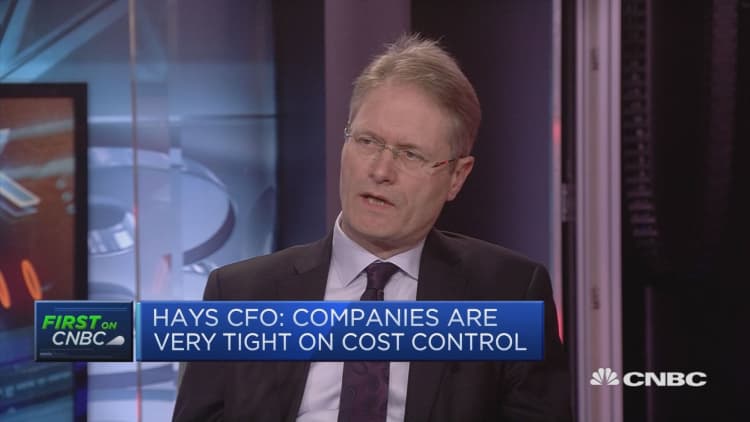
U.S. stocks closed sharply higher Monday, regaining more than half of their correction-level losses amid a stabilization in interest rates.
The Dow Jones industrial average added 399.28 points to close at 25,709.27 on the week's first day of trading with industrial titans Boeing and 3M contributing the most to the blue-chip index. The gained 1.18 percent to close at 2,779.60 after strong performance in telecommunications, technology and financials stocks.
Berkshire Hathaway Class B stock led financial stocks higher with a 3.88 percent gain after CEO Warren Buffett told investors that, should the company fail to find any market bargains, it will likely return cash to shareholders.
The Dow and S&P 500 have more than halved their correction losses. From the Dow and S&P's 52-week intraday highs, the indexes are down 3.4 percent and 3.25 percent respectively through Monday's close.
The Nasdaq composite, meanwhile, climbed 1.15 percent to finish at 7,421.46 thanks to a nearly 2 percent rally in Apple shares and a 2.8 percent gain in Intel. The Cboe Volatility index (VIX) — the market's best fear gauge — hit a low of 15.97 in a choppy session, its lowest level since Feb. 2.
"The economy is still in acceleration mode. That's true here and generally overseas," said Maris Ogg, president at Tower Bridge Advisors. "I don't really see things getting out of whack or an economic imbalance that would suggest you're nearing the end of the uptrend."
"The next thing we've got to think about is when we hit the end of the year and the comparisons get tougher," she added.
The yield on the 10-year Treasury note stabilized just under the key psychological level of 3 percent over the past few weeks. At the latest reading, the yield on the benchmark 10-year note traded at 2.862 percent, below its high of 2.95 percent hit last week.
That has given stocks some breathing room, with the Dow Jones industrial average up more than 1,100 points over the past two weeks of trading. The so-called "FAANG" stocks — including Facebook, Apple, Amazon, Netflix, and Google-parent Alphabet — have already returned to pre-correction levels.
An equal-weighted portfolio of the stocks is up 18.4 percent this year, versus the S&P 500's 2.8 percent gain, Bespoke said in a Friday report.
"I am fairly optimistic about the current state of the economy," said Fed Governor Randal Quarles in prepared remarks on Monday. "Along many dimensions, it has been quite some time since the economic environment has looked as favorable as it does now."
The new Fed governor noted that with the economy appearing healthy, the central bank should prepare for further interest rate increases to keep growth and markets from overheating.
General Electic, on the other hand, broke below $14 per share after naming three new directors to its board. The latest depreciation in shares price comes after months of turbulent times for the original Dow member; new chief executive officer John Flannery has pledged to trim the company by exiting several businesses.
While U.S. government debt yields remained under pressure Monday, concerns around the future of the economy and monetary policy in the States keep markets on edge.
"We've a got a full slate of economic data which should probably be the most important thing [this week]," said Art Hogan, chief market strategist at B. Riley FBR, referring to key inflation metrics. "Earnings are great and they're better for tax reform, while economic data continues to improve."
The strategist noted that a number of companies are set to report this week, including consumer-facing companies like Lowe's, and that a calmer debt market seems to have stabilized equities for the moment. Hogan believes market consensus sees 3 rate hikes from the Federal Reserve in 2018.
New Fed Chair Jerome Powell is set to address Congress on Tuesday, when he is expected to address monetary policy in his first semiannual economic testimony. Though many market experts hope Powell will pacify an ongoing tug-of-war between bonds and stocks, the central bank could stick to script and assure lawmakers of a continued, gradual path of rate hikes.
The Fed's preferred inflation data, personal consumption expenditures (PCE), will be released Thursday.
"I would think there's no upside for [Powell] making a splash because he's dealing with a committee that's in flux, just coming together," said Robert Tipp, chief investment strategist at PGIM Fixed Income. "The market tends to do a good job of panicking and defining the range you're likely to be in ... Once the taper tantrum got going, 3 percent was the watermark."
In other data news, sales of new homes fell for a second straight month in January. The Commerce Department said on Monday that sales dropped 7.8 percent; economist polled by Reuters had forecast new home sales up nearly 4 percent.
The contraction in sales is being blamed largely on a shortage in houses as well as rising mortgage rates.
Looking at markets overseas, both stocks in Europe and Asia posted solid gains Monday. The German DAX traded up 0.35 percent while Japan's Nikkei 225 climbed nearly 1.19 percent.
Investors will be waiting for news surrounding the NRA's relationship with leading businesses, with a growing list of companies choosing to end their partnerships following the mass shooting at a public high school in Florida.
WATCH: Seeing a lot of investment from US into Europe




